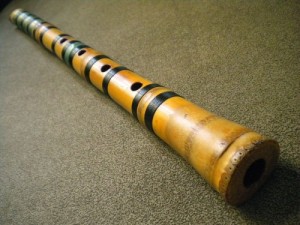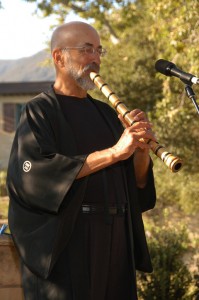 Before a full house in New York City’s Philharmonic Hall, the Japanese soloist played brilliantly, imitating to perfection the sound of wind blowing through a bamboo grove. The subtle tone, the oscillating rhythm was an exotic, even puzzling experience for the audience. For this night, November 9, 2011, marked the Western debut of the shakuhachi in a work entitled “November Steps” by avant-garde composer Toru Takemitsu.
Before a full house in New York City’s Philharmonic Hall, the Japanese soloist played brilliantly, imitating to perfection the sound of wind blowing through a bamboo grove. The subtle tone, the oscillating rhythm was an exotic, even puzzling experience for the audience. For this night, November 9, 2011, marked the Western debut of the shakuhachi in a work entitled “November Steps” by avant-garde composer Toru Takemitsu.
In the opinion of the New York Times critic, soloist Katsuya Yokoyama displayed a control of the lovely mellow tone of the shakuhachi that could have made the Philharmonic flute players envious. Indeed, this ancient Japanese instrument is being rediscovered and praised by renowned musicians around the world. Amateur music enthusiasts of all ages, occupations and nationalities are taking it up. In Japan, the shakuhachi is more popular than ever in the traditional kabuki theater and as accompaniment for folk songs.
What is the fascination of this recorder-like flute for contemporary musicians? The shakuhachi, more than a thousand years old, is the simplest of musical instruments, yet, in the hands of a master, it has a spectrum of jewel-like tones that no Western woodwind can match. “In the hands of an expert,” says Katsuya Yokoyama, “the timbre of the bamboo flute may range from a sound as clear and frivolous as the tinkling of a metal bell to passionate, breathy sound that seem to contain the sound of the universe.”
Its structure is deceptive. It is simply a tube of raw bamboo, about two feet long, hollow from mouthpiece to tip, with four holes down the front and one in back. It has a musical scale consisting of five notes. In Western terms, they are D-F-G-A-C (Re-Fa-So-La-Do). On the basis of this pentatonic scale, the shakuhachi player with a versatile technique can produce a wide range of unique and highly personal tones.
It takes years of study to perfect the various techniques. Traditionally, an average of three years of practice was considered necessary to learn the basic head movements, although today’s students can learn them much faster, thanks to the introduction of more sophisticated methods. By sticking out his chin and slightly raising the tip of the flute, the player can lower the pitch of a note by half. This technique is called meri. Raising the pitch by half, called kari, is accomplished by moving the tip of the flute slightly downward. By the same token, it no longer takes the eight years once required to master koro, the delicate fingering techniques that produce derivative notes: half-opening, a hole covered only halfway by a finger; quarter-opening, a hole covered a quarter of the way; and so on.
Once the student of shakuhachi has mastered the various techniques and has learned to control his breathing, he can project his own personal feelings through the instrument. This magnitude of musical expression is the striking feature of the shakuhachi. To play the bamboo flute is to escape from the doctrine of traditional Western music that says a musician must follow his score precisely and tune his instrument to a designated pitch. With the shakuhachi, the musician is free to express himself. His score provides only skeletal instructions: the notes. It does not tell when to play staccato or legato. Therefore, each player will interpret a given piece his own distinct way. This chance for individuality and freedom of expression is the appeal for modern musicians.
 These thoughts were underscored by electronic-music composer Makoto Moroi who, after hearing his first shakuhachi concert, said: “Each sound of the bamboo flute is full of life and personality. It may very well be the instrument to recover humanity and communication it the world. Electronic music has lost sight of the significance of human involvement in music.” Form that night on, Moroi, who had won awards all over the world for his electronic music, underwent a drastic conversion. He has been composing works for the shakuhachi ever since.
These thoughts were underscored by electronic-music composer Makoto Moroi who, after hearing his first shakuhachi concert, said: “Each sound of the bamboo flute is full of life and personality. It may very well be the instrument to recover humanity and communication it the world. Electronic music has lost sight of the significance of human involvement in music.” Form that night on, Moroi, who had won awards all over the world for his electronic music, underwent a drastic conversion. He has been composing works for the shakuhachi ever since.
The origins of this miraculous flute are rooted in the traditions of Zen Buddhism. Legend has it that in China, during the 9th century, a high-ranking Zen priest named Fuke breathed his last after preparing his own coffin, lying down in it and having a passerby nail on the lid. Hearing of this, people heard the sound of the bell Fuke used to tinkle while soliciting alms.
History records that a Japanese Buddhist named Kakushin, who studied Zen Buddhism in China about 700 years age, became interested in the shakuhachi music during this stay. When he completed his Buddhist training in China, Kakushin returned to Japan carrying the shakuhachi and a special melody with him. This melody, called kyorei, was said to embody the sound of Fuke’s bell tinkling in the air after he was gone. In the years that followed, Kakushin taught all of his pupils to play the bamboo flute.
One of kakushin’s disciples, Priest Kyochiku, became a master a playing the shakuhachi and,in turn, composed a number of classical shakuhachi melodies. The melody kyoku, for instance, suggests the image of the bell tinkling during intervals of mist. Through playing his shakuhachi music, Kyochiku felt his mind being released from physical considerations; he relaxed and was absorbed into the perfect state of Zen consciousness – a soaring spiritual happening.
To perpetuate this experience, referred to as suizen (“playing the essence of Zen”), Kyochiku founded the Fuke sect of Zen Buddhism. The shakuhachi became the symbol of this new sect. it was literally and figuratively a sacred instrument. In Kyoto, Kyochiku erected a temple called Myoanji, where priestes of the Fuke sect learned to play the shakuhachi. Then, wearing cone-shaped hats and clad in priestly robes, the komuso (“shakuhachi-playing priests”) left Kyoto and walked all over Japan playing their bamboo instruments and spread the teachings of their Buddhist sect.
In ancient days, the strolling komuso were a familiar sight in neighborhoods throughout Japan. During the Yedo Period (1603-1867), common people had become so captivated by the timbre of the shakuhachi that they solicited the komuso to give them lessons. Thus, over the course of centuries, the bamboo flute became deeply entwined in the sacred and the secular life of Japan.
Today, Myoanji Temple is the mecca of shakuhachi players. The style of shakuhachi music taught there is called Myoan. One need not be a priest to study at Myoanji. Anyone can participate in the practice sessions. What brings these people together is a common desire to forget themselves and become immersed in the ecstasy of Zen while playing the bamboo flute.
Besides the Myoan school, there are as many as five schools of shakuhachi. Nakao Tozan, once a komuso at Myoanji Temple, founded one of the largest schools. In his youth, Tozan strenuously practiced the bamboo flute in a certain grove on Mt. Otokoyama, near Kyoto. Here a monument stands dedicated to this master musician. Every February 15, more than 100 shakuhachi players – doctors, bankers, civil servants, farmers, clerks, teachers, students – gather around the monument and, in concert, play a piece composed by Tozan especially for the bamboo flute: “Iwashimizu” (“spring issuing from the rocks”).
The enchanting melody floats over the grove, down the bamboo-covered mountain in harmony with the rustling of bamboo leaves and trickling springs. Softened by fallen leaves, it eventually joins the rushing river far below.
As composer Moroi has suggested, the bamboo flute may indeed be the best instrument in music. It is a wondrous instrument, full of vitality. Though it is more than a thousand years old, a new chapter in its long life may be must beginning.